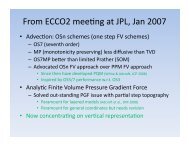A Framework for Handling Geophysical Datasets with the ... - ECCO2
A Framework for Handling Geophysical Datasets with the ... - ECCO2
A Framework for Handling Geophysical Datasets with the ... - ECCO2
You also want an ePaper? Increase the reach of your titles
YUMPU automatically turns print PDFs into web optimized ePapers that Google loves.
In fact, inheritance is an ’is-a’ relationship: Lassie is a Collie. A Collie is a<br />
Dog. Thus, Lassie inherits <strong>the</strong> methods of both Collies and Dogs. (Source:<br />
WIKIPEDIA).<br />
b) Polymorphism in OOP is <strong>the</strong> ability of objects belonging to different data types<br />
to respond to method calls of methods of <strong>the</strong> same name, each one according<br />
to an appropriate type-specific behavior. One method, or an operator such<br />
as +, -, or *, can be abstractly applied in many different situations. If a<br />
Dog is commanded to speak(), this may elicit a bark(). However, if a Pig is<br />
commanded to speak(), this may elicit an oink(). They both inherit speak()<br />
from Animal, but <strong>the</strong>ir derived class methods override <strong>the</strong> methods of <strong>the</strong><br />
parent class. This is Overriding Polymorphism. (Source: WIKIPEDIA).<br />
Matlab naturally uses <strong>the</strong>se two OOP features. For example, adding integer<br />
values in Matlab calls a different plus.m function than does adding two matrices. It<br />
is easy to grasp how one might expand this approach towards geophysical datasets,<br />
<strong>with</strong> different datasets needing different strategies <strong>for</strong> data extraction.<br />
In line <strong>with</strong> OOP philosophy this framework defines a base class (ModelData)<br />
which is capable of handling standard reading/ writing tasks. In addition, this class<br />
implements <strong>the</strong> infrastructure that all o<strong>the</strong>r child classes may use. This includes<br />
elementary functions allowing to set/ get object attributes, but also more complex<br />
tasks like adding additional geophysical fields which may exist due to <strong>the</strong> specific<br />
dataset structure. The base class does not know about <strong>the</strong> specific geophysical prop-<br />
erties of a certain dataset and hence only <strong>the</strong> basic (native) variables are initialized<br />
when using <strong>the</strong> ModelData object.<br />
This concept is extended by defining child classes that contain <strong>the</strong> specific in-<br />
<strong>for</strong>mation about a certain dataset (such as names of variables, coordinates, z-levels,<br />
etc.). More specifically this means assigning each substantial different dataset its<br />
own class or object. This is similar to what has been described <strong>for</strong> <strong>the</strong> dog-class<br />
example above.<br />
For example a ROMS output file would be assigned a roms object. An ECCO<br />
output file would be assigned an ecco object and so <strong>for</strong>th. Each of <strong>the</strong>se objects are<br />
child classes of <strong>the</strong> ModelData class. Hence <strong>the</strong>y inherent some basic e.g. netcdf<br />
reading capabilities. Fur<strong>the</strong>rmore each class implements a method getdata which<br />
knows exactly how to extract and access <strong>the</strong> data <strong>for</strong> <strong>the</strong> specific data type. In<br />
accordance <strong>with</strong> polymorphism this method may or may not overwrite <strong>the</strong> original<br />
getdata method as implemented by ModelData, but may use ModelData capabilities<br />
to per<strong>for</strong>m basic reading tasks.<br />
6




